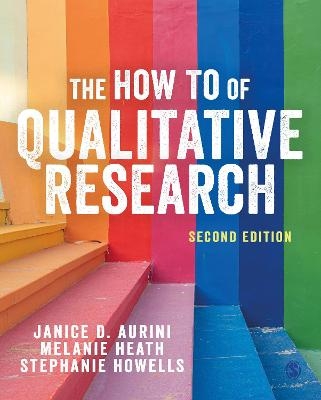
The How To of Qualitative Research
SAGE Publications Ltd (Verlag)
978-1-5264-9505-1 (ISBN)
This book will support you through each milestone of your research project with step-by-step instructions to doing qualitative research.
Whatever type of data or data collection method you use, it will help you to navigate the nuts and bolts of qualitative research, from forming your research question to effectively writing up.
Your roadmap and toolbox all in one, it helps you choose the best research tools for your project while managing any challenges you might encounter along the way. It includes:
· Guidance on putting different research designs into practice, including using technology for interviews, data management, and unobtrusive research
· Practical mapping tools, including checklists and quick tips
· Online case studies and further reading to deepen your knowledge and expand your bibliography
· Advice from experts on how to design and implement excellent qualitative research, including considerations of ethical issues.
This book is the perfect companion for social sciences students carrying out their first qualitative research project.
Janice Aurini is an Associate Professor in the Department of Sociology and Legal Studies at the University of Waterloo. She completed her Ph.D. at McMaster University and was a postdoctoral fellow at Harvard University. Her research examines education policy, inequality, private education, and parenting. Dr. Aurini has conducted field work, video-recorded observations, interviews, focus groups with children and adults, and photo-interviews. She has also worked on several mixed methods and large-n qualitative projects. Her recent articles can be found in Sociology of Education, Canadian Public Policy, Qualitative Research, and the European Journal of Higher Education. She is currently the primary investigator on a SSHRC funded project on upper-middle-class parenting in three countries. Melanie Heath is an Associate Professor in the Department of Sociology at McMaster University. She completed her Ph.D. at University of Southern California and was a postdoctoral fellow at Rice University. Her research examines gender, sexuality, and family politics. Dr. Heath has conducted field work, interviews, focus groups, and textual analysis. She is author of One Marriage Under God: The Campaign to Promote Marriage in America (New York University Press, 2012). Her forthcoming book on comparative government regulation of polygamies is titled, Forbidden Intimacies: Transnational Regulation of Polygamies at the Limits of Western Tolerance (Stanford University Press). Her recent work has been published in Gender & Society, Signs, Qualitative Sociology, Sociological Perspectives, Sociological Quarterly, and Contexts. Stephanie Howells is an Assistant Professor in the Department of Sociology and Anthropology at the University of Guelph. She completed her Ph.D. in the Department of Sociology at McMaster University. Her research is generally centered on education, crime, violence and youth. She has worked on several mixed methods research projects, and has conducted focus groups, personal interviews, and media analyses in her qualitative research. Her research has been published in Higher Education Policy and Policing. She is currently co-investigator on a SSHRC funded Partnership Development Grant called From NIMBY to Neighbour: Brokering a dialogue about homelessness among police, people experiencing homelessness and the community.
Part I: Jump Starting Your Qualitative Research Project
Chapter 1: Introduction: From Why to How in Qualitative Research
What is Qualitative Research?
A pragmatic approach to qualitative research: What this book is (and is not) about
Chapter 2: How to Conceptualize Research: Getting Started and Advancing Ongoing Projects
Step One: Selecting a topic
Step Two: How to Use the Literature to Conceptualize
Step Three: Take a step back
Chapter 3: How to Design a Qualitative Project: Selecting the Right Tools for the Job
Step One: Develop Research Question(s)
Step Two: Connecting Research Question(s) to Methods
Step Three: Developing a sampling strategy
Chapter 4: Taking a Step Back: How to Build Methodological and Ethical Integrity into your Research
Step One: Feasibility and fit
Step Two: Trustworthiness
Step Three: Sample size and saturation
Step Four: Ethical considerations
Part II: The Ins and Outs of Collecting Qualitative Data
Chapter 5: How to Do Interviews: Making What People Say Matter
Step One: Types of interviews
Step Two: Method of interviewing
Step Three: Getting prepared
Step Four: Data collection tools
Step Five: Closing the deal
Step Six: Interviewing techniques
Step Seven: Transcription decisions
Step Eight: Managing interview data
Chapter 6: How to Do Focus Groups: Making the Most of Group Processes
Step One: Types of focus groups
Step Two: Group size and sample size
Step Three: Group composition
Step Four: Group dynamics
Step Five: Incentives
Step Six: Roles
Step Seven: Selecting a location
Step Eight: The discussion guide
Step Nine: Recording
Chapter 7: How to Conduct Field Research: Getting in and Getting out with High Quality Data
Step One: Types of field research
Step Two: What is the ‘field’?
Step Three: Theoretical development
Step Four: Gaining access
Step Five: You’re in, now what? Negotiating roles in the field
Step Six: Time matters: How long is enough?
Step Seven: Field notes: Data recording and organizational devices
Chapter 8: How to Use Unobtrusive Methods: The Beauty of Social, Physical and Visual Artefacts
Step One: Types of unobtrusive data
Step Two: Collecting unobtrusive data: Key considerations and tools
Part III: Analysing and Writing Up Your Research
Chapter 9: How to Do Data Analysis: The Beginner’s Guide to Coding
Step One: Getting prepared
Step Two: Pre-coding, first cycle and second cycle coding
Chapter 10: How to Write up Qualitative Research: Making Your Words Count
Step One: Writing up Qualitative Research: Style and Substance
Step Two: Presenting your data
Step Three: Tips for good writing
Step Four: Effectively responding to reviewer comments
| Erscheinungsdatum | 29.12.2021 |
|---|---|
| Verlagsort | London |
| Sprache | englisch |
| Maße | 186 x 232 mm |
| Gewicht | 800 g |
| ISBN-10 | 1-5264-9505-8 / 1526495058 |
| ISBN-13 | 978-1-5264-9505-1 / 9781526495051 |
| Zustand | Neuware |
| Haben Sie eine Frage zum Produkt? |